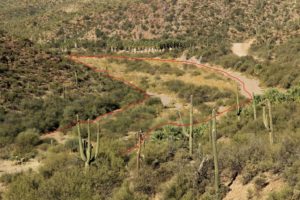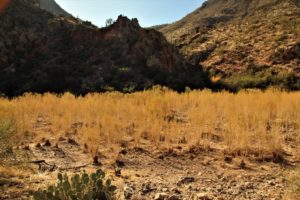Invasive Species
Salt cedar trees grow rampantly in the Middle East, Asia, and parts of Africa, accustomed to harsh landscapes with little rain. They first appeared on the East Coast of America in the early 1800s, carried over the sea and sold to plant nurseries as ornamental shrubs. The brushy trees flourished in saline soils, their grey-green leaves rough-textured with salt. Scientists call the species Tamarix, but most people know it by the nickname “salt cedar” or tamarisk.
By the early 1900s, farmers in Arizona, southern California, and other western states had begun planting salt cedar to act as windbreaks, stabilize the soil, and provide much-needed shade over the evaporating surfaces of streams. The hardy desert shrub took a liking to its new ecosystem. Downy seeds scattered in the dry desert breeze. Soon, slender salt cedar shrubs sprouted on their own accord along river bottoms.
The salt-cedar is at a massive advantage due to its deep burrowing root system that can access water far out of reach of the native phreatophytes such as cottonwoods and various willow species. The salt-cedar has become extremely common in the waterways across the southwest, completely usurping the native vegetation and creating an environment in which few species of flora or fauna can thrive in.
Threat(s):
Ecosystem Threat
Riparian ecosystems have been so detrimentally affected by saltcedar and other factors that they may possibly be the rarest ecosystem in North America. The monotypic stands of saltcedar aggressively replace willows, cottonwoods, seepwillow/baccharis and other native riparian vegetation.
Water
Saltcedar is a very great consumer of water: a single large plant can absorb 200 gallons of water a day. This can result in the lowering of the ground water, drying up of springs and marshy areas, as well as reduction in water yield of riparian areas (along the Colorado River it has been estimated that up to 568,000 acre feet of water are lost per year to channel vegetation, with saltcedar being a major component). Saltcedar’s dense roots can slow down river flow, increasing deposition, and increasing sediments along the riverbank. This can lead to saltcedar colonization further into the floodplain, widening the riparian zone, resulting in severe reduction of streamflow or even rechanneling. On the other hand, saltcedar root systems can also lead to flooding through choking of the watercourse.
Animal Impact
Although it can provide nesting area for some species, avian density and diversity decreases dramatically when saltcedar is present. It has been found that saltcedar stands supported only four species per hundred acres, in comparison to 154 species per hundred acres of native vegetation. Saltcedar communities also tend to have smaller numbers of insects as well.

In the above photo, the area outlined in red is filled with the non native salt cedar or Tamarisk tree. This area is approximately 1 mile north of the Castle Hot springs resort on castle Hot Springs Road. This photo was taken in February 2018. In 2017 this area was virtually free from this vegetation. Water flowed intermittently throughout the creek. There is very little above ground flow in the creek bed this year.

This is in the creek bed from the first picture. The shear amount and size of these saltcedars that sprung up after a wet winter is concerning. There is a lot of wildlife that use this area for water. Water that is being sucked up by the saltcedar.
Control Method:
Saltcedar is difficult or impossible to kill by burning, drought, freezing, hypersalinity, prolonged submersion, or repeated cutting at ground level. However, it can possibly be controlled through a combination of methods.
Mechanical and Chemical Combination
Because saltcedar can very effectively resprout from roots or cut stems, simple removal of the plant is largely unsuccessful. Cutting down the tree in combination with direct chemical treatment of the stump with various herbicides (those shown to be effective against saltcedar) has been successful. Some studies in New Mexico have also described arial chemical treatment as able to achieve “90-99% control.”
Fire and Chemical Combination
Prescribed burning alone is not an effective control method for saltcedar because it generally promotes sprouting and flowering. However, burning followed by herbicide application has been shown to be effective.
Biocontrol Research has indicated that approximately a dozen insect species are available that might be useful in fighting saltcedar, but none are presently available. Two species in consideration are: saltcedar leaf beetle (Diorhabda elongat), and manna scale (Trabutina mannipara). In its native range, 115 insect species and four mites are known to attack saltcedar. By feeding on the saltcedar, the biocontrol insects could have a great impact on population growth.
Support our mission: [wpedon id=”2126″ align=”left”]